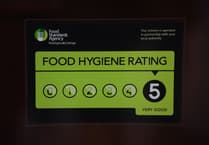A new report has deemed Powys the 10th best place in Wales for high food hygiene ratings.
The report comes from online training provider High Speed Training, marking 15 years since the introduction of the Food Hygiene Rating Scheme.
The report, which analysed Food Standards Agency (FSA) data for over 240,000 food businesses across England, Scotland, Northern Ireland and Wales, found that in Wales, the average food hygiene rating across all food establishments was 4.47 from over 13,000 premises, which places Wales in 7th position when compared to regions of the UK.
Powys moved two places down in the rankings from last year, along with Port Talbot. Torfaen had the biggest improvement in average rating with an increase of 0.19, though it still placed in the bottom half of the local authorities list. Its average rating in 2024 was 4.16.
The top ranking local authority in Wales was Wrexham, with an impressive average score of 4.90 from over 400 premises, meaning it would rank joint 5th in a list of towns and cities from across the UK.
Cardiff (4.37) ranked 13th in Wales, improving its rating by 0.03 from 2024. Swansea placed 15th in Wales, with a rating of 4.25.
The lowest average rating in Wales went to Blaenau Gwent, with an average score of 3.94, meaning that they would rank bottom when compared to towns and cities across the UK.
High Speed Training’s report also found that more than 1 in 4 takeaways (25.3%) across Wales scored 3 or below for their food hygiene rating, with 36 premises scoring a zero for their rating, and 696 scoring a one. 86.7% of all premises across Wales scored a 4 or a 5, with 89.3% of restaurants and cafes achieving a 4 or a 5 for their score.
The Food Hygiene Rating Scheme (FHRS) is a partnership with local authorities in England, Wales and Northern Ireland that was launched in 2010. It replaced a number of regional schemes, with the aim of providing hygiene information clearly and more effectively across the UK.
Following regular inspections, ratings are devised based on the standard of food handling hygiene, the physical condition of the premises and facilities and food safety management practices.
These ratings are then made available on the Food Standards Agency (FSA) website and are usually visible from outside of the premises, often presented in a window near the entrance.
In Wales and Northern Ireland, it is compulsory for businesses to display their food hygiene rating. However, in England it is currently just considered best practice.
Paul Turner CEnvH, MCIEH, an Environmental Health Officer for North Yorkshire Council, said: “Since its inception 15 years ago, the Food Hygiene Rating Scheme has played a pivotal role in improving standards across the UK. It has been incredibly successful in allowing local authorities and EHOs to effectively engage with both businesses and consumers to communicate important messages around food hygiene and safety.
“Prior to the launch, a number of regional ‘Scores on the Doors’ schemes existed that, though they were effective, didn’t easily allow for national comparison and benchmarking. A national standard means greater consistency for businesses and provides the public easy access to this vital information.
“However, we would welcome some updates to the FHRS to make it more suitable for the current landscape, which relies heavily on food delivery apps and aggregators. We would like to see this information displayed more prominently across these apps, perhaps with a traffic light system for easy identification.
“We are also always pushing to make the display of food hygiene ratings in England mandatory, as it is in Wales and Northern Ireland, to ensure that consumers have all the information they need to make informed choices about where to spend their hard-earned money.”
Dr Richard Anderson, Head of Learning and Development at High Speed Training comments: “Food safety and robust hygiene practices should be of paramount importance to food businesses, and to the customers who use them. 15 years have passed since the launch of the Food Hygiene Rating Scheme, and its place in the industry is as vital as ever. These ratings are a direct reflection of how safely and hygienically that establishment operates, and we urge businesses and customers to take them seriously.
“For businesses that perform well, a high rating is a real selling point. However, establishments with a low hygiene rating can be extremely off-putting for customers, which ultimately have a significant impact on reputation and profitability.”
“Our report shows that, on average, standards remain high across the UK, and have improved from 2024. This commitment to correct food hygiene training for staff, alongside robust food management procedures and everyday good practices are crucial to keep performing at high standards.
“We would also urge customers to check the food hygiene ratings of establishments they wish to dine at, so that an informed call as to whether you eat there can be made.”





Comments
This article has no comments yet. Be the first to leave a comment.